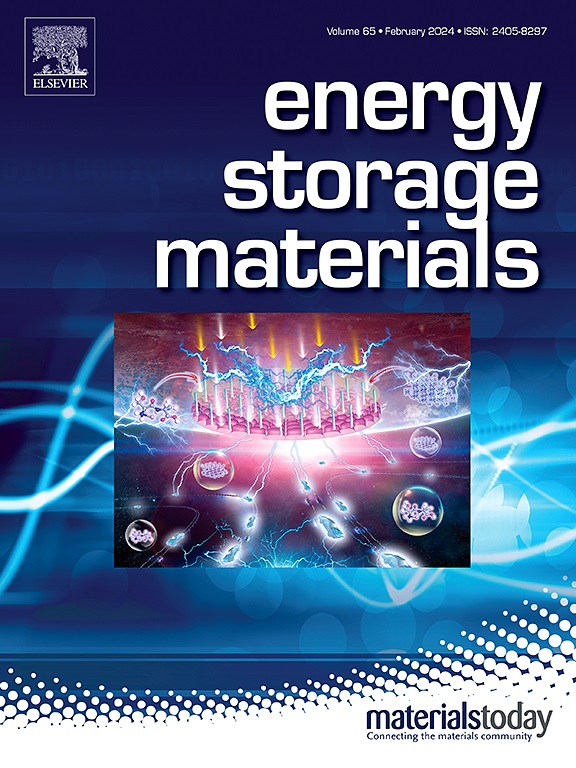提高锂金属电池界面稳定性的阴离子-稀释剂协同策略
IF 18.9
1区 材料科学
Q1 CHEMISTRY, PHYSICAL
引用次数: 0
摘要
近年来,高压锂金属电池(lmb)作为高能量密度储能器件显示出巨大的潜力。然而,目前的电解质很难同时在锂阳极和高压阴极上形成稳定的界面膜,导致高压lmb的循环稳定性不理想。本文将具有大π共轭结构的双(草酸)硼酸锂(LiBOB)和富氟氢氟醚(HFE)共同引入到传统的醚电解质中,以平衡偶极子-偶极子相互作用。这导致形成弹性富F和富b - o的阳极界面层和坚固的富硼阴极-电解质界面(CEI),从而具有优越的循环能力。因此,Li||铜电池在1ma cm−2和1mah cm−2下的循环寿命为9500小时,是目前报道的最好的。在4.5 V下循环160次后,Li||LiCoO2电池的容量保持率为82.32%,平均CE为>;99.9%。对应Li||NCM811袋状电池(5 Ah, 400 Wh/kg;3.3 Ah, 434 Wh/kg)在0.5℃下可稳定循环200次和130次。这项工作为高能量密度和长寿命lmb的醚基电解质的商业化提供了一种新颖有效的策略。本文章由计算机程序翻译,如有差异,请以英文原文为准。
Anion-diluent synergistic strategy for improved interfacial stability in lithium metal batteries
Recently, high-voltage Li metal batteries (LMBs) have shown great potential as high-energy-density energy storage devices. However, current electrolytes struggle to form stable interfacial films on both the Li anode and high-voltage cathode simultaneously, leading to unsatisfactory cycling stability in high-voltage LMBs. Here, lithium bis(oxalate)borate (LiBOB) with a large π conjugate structure and fluorine-rich hydrofluoroether (HFE) are co-introduced into conventional ether electrolyte to balance dipole-dipole interactions. This results in the formation of an elastic F- and B-O-rich anodic interfacial layer and a robust boron-rich cathode-electrolyte interphase (CEI), leading to superior cycling ability. Consequently, the Li||Cu cell shows an extremely long cycle life of 9500 h under 1 mA cm−2 and 1 mAh cm−2, which is the best as reported so far. The Li||LiCoO2 cells exhibit a superior capacity retention of ∼82.32% under 4.5 V after 160 cycles, with an average CE of > 99.9%. The correspondent Li||NCM811 pouch cells (5 Ah, 400 Wh/kg; 3.3 Ah, 434 Wh/kg) could stably cycle at 0.5 C for 200 cycles and 130 cycles, respectively. This work offers a novel and effective strategy to commercialize ether-based electrolytes for high-energy-density and long-life LMBs.
求助全文
通过发布文献求助,成功后即可免费获取论文全文。
去求助
来源期刊

Energy Storage Materials
Materials Science-General Materials Science
CiteScore
33.00
自引率
5.90%
发文量
652
审稿时长
27 days
期刊介绍:
Energy Storage Materials is a global interdisciplinary journal dedicated to sharing scientific and technological advancements in materials and devices for advanced energy storage and related energy conversion, such as in metal-O2 batteries. The journal features comprehensive research articles, including full papers and short communications, as well as authoritative feature articles and reviews by leading experts in the field.
Energy Storage Materials covers a wide range of topics, including the synthesis, fabrication, structure, properties, performance, and technological applications of energy storage materials. Additionally, the journal explores strategies, policies, and developments in the field of energy storage materials and devices for sustainable energy.
Published papers are selected based on their scientific and technological significance, their ability to provide valuable new knowledge, and their relevance to the international research community.
 求助内容:
求助内容: 应助结果提醒方式:
应助结果提醒方式:


